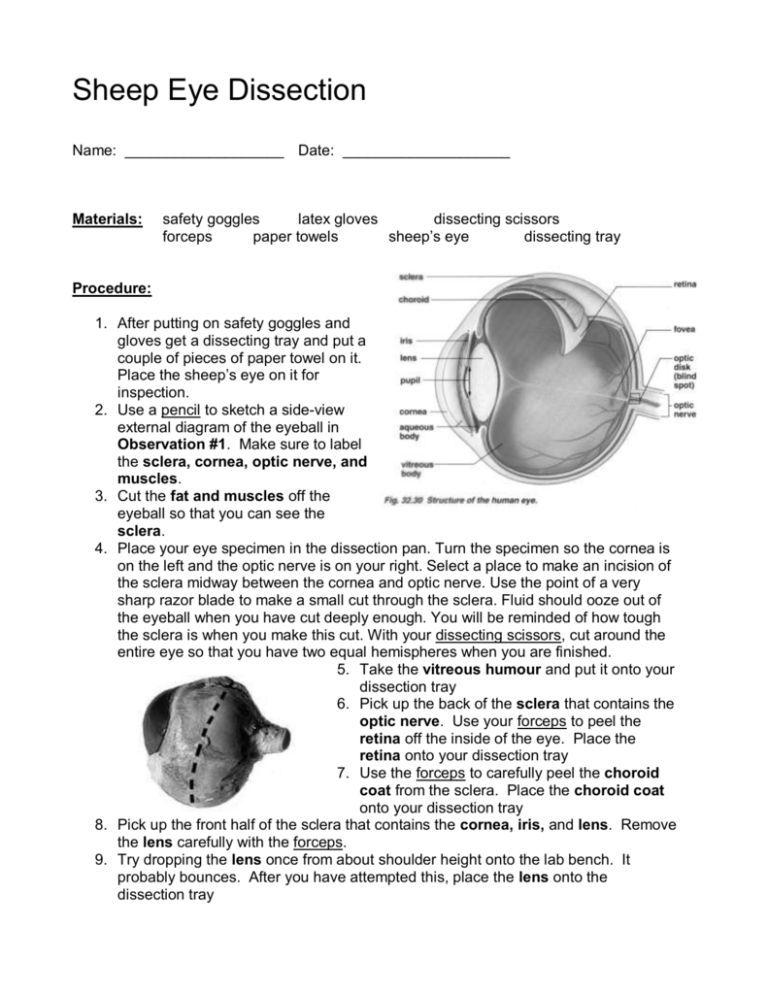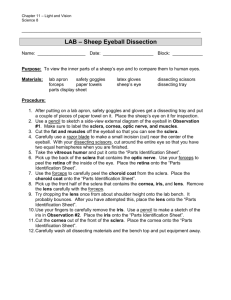Sheep Eye Dissection Lab Worksheet
advertisement

Sheep Eye Dissection Name: ___________________ Date: ____________________ Materials: safety goggles latex gloves dissecting scissors forceps paper towels sheep’s eye dissecting tray Procedure: 1. After putting on safety goggles and gloves get a dissecting tray and put a couple of pieces of paper towel on it. Place the sheep’s eye on it for inspection. 2. Use a pencil to sketch a side-view external diagram of the eyeball in Observation #1. Make sure to label the sclera, cornea, optic nerve, and muscles. 3. Cut the fat and muscles off the eyeball so that you can see the sclera. 4. Place your eye specimen in the dissection pan. Turn the specimen so the cornea is on the left and the optic nerve is on your right. Select a place to make an incision of the sclera midway between the cornea and optic nerve. Use the point of a very sharp razor blade to make a small cut through the sclera. Fluid should ooze out of the eyeball when you have cut deeply enough. You will be reminded of how tough the sclera is when you make this cut. With your dissecting scissors, cut around the entire eye so that you have two equal hemispheres when you are finished. 5. Take the vitreous humour and put it onto your dissection tray 6. Pick up the back of the sclera that contains the optic nerve. Use your forceps to peel the retina off the inside of the eye. Place the retina onto your dissection tray 7. Use the forceps to carefully peel the choroid coat from the sclera. Place the choroid coat onto your dissection tray 8. Pick up the front half of the sclera that contains the cornea, iris, and lens. Remove the lens carefully with the forceps. 9. Try dropping the lens once from about shoulder height onto the lab bench. It probably bounces. After you have attempted this, place the lens onto the dissection tray 10. Use your fingers to carefully remove the iris. Use a pencil to make a sketch of the iris in Observation #2. Place the iris onto the dissection tray 11. Cut the cornea out of the front of the sclera. Place the cornea onto the dissection tray. 12. Carefully wash all dissecting materials and the bench top and put equipment away. Observations/Discussion: Observation #1 – External Diagram of Eye Observation #2 – Iris Diagram 1. What is the job of the muscles on the outside of the eyeball? _______________ 2. What colour is the sclera? _________ Iris? _________ Pupil? _________ 3. What did you observe about the texture of the sclera while cutting? Why is this a good feature for eyes to have? _______________________________________ 4. What is the job of the vitreous humour? ________________________________ 5. What is the function of the retina? ____________________________________ 6. You may have found it difficult to remove the retina. What may have made it difficult to remove? ________________________________________________ 7. The place where the retina and optic nerve connect is called the blind spot. Why is a blind spot produced? ___________________________________________ 8. The black, shiny layer under the retina is the choroid coat. What does the choroid coat contain and what is the function of this layer? _________________ ________________________________________________________________ 9. What is the purpose of the aqueous humour? Where is it located in the eye? ____________________________________________________________ 10. What shape is the lens? Why is it important that it acts like a magnifying glass? ________________________________________________________________ 11. Why is it important that the lens is flexible? _____________________________ 12. What is the hole in the middle of the iris called? What is the function of the iris? Is the iris transparent, translucent or opaque? ________________________________________________________________ 13. What is the function of the lens? _____________________________________ 14. The cornea is normally clear and colourless so that light can be refracted through it. In your sheep’s eye the cornea may be cloudy. What do you think may have caused this? _____________________________________________________ 15. Label the diagram with parts of the sheep’s eye. (Hint: See boldface words!) 16. Write the names of the actual eye parts. (Hint: See boldface words!) a. Thick outer casing of eye b. Shiny, black with blood vessels c. Thin layer registering images d. Cord carrying messages to brain e. Connection-no info registers f. Jelly – like liquid prevents damage g. Controls amount of light entering h. First window protects and focuses i. Opening in coloured muscle j. Final focusing transparent ball k. Watery liquid feeds front of eye l. Stretch and relax to move parts











